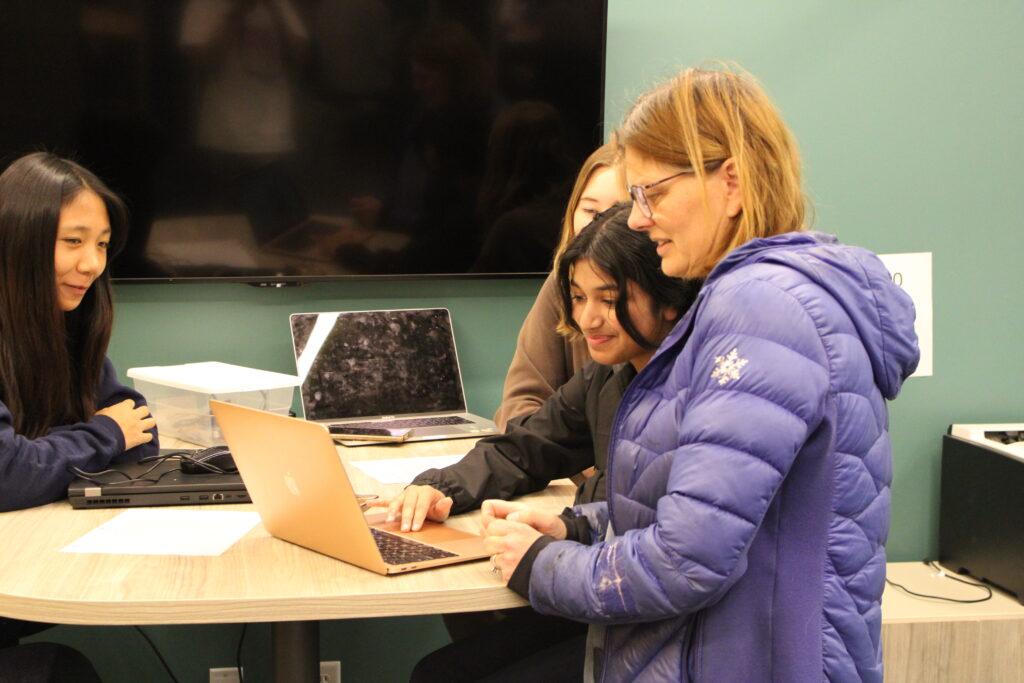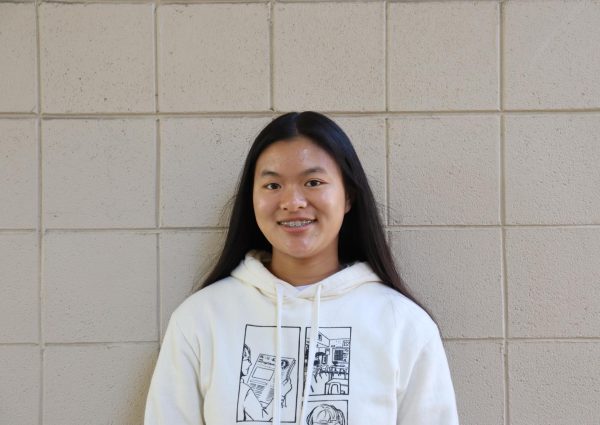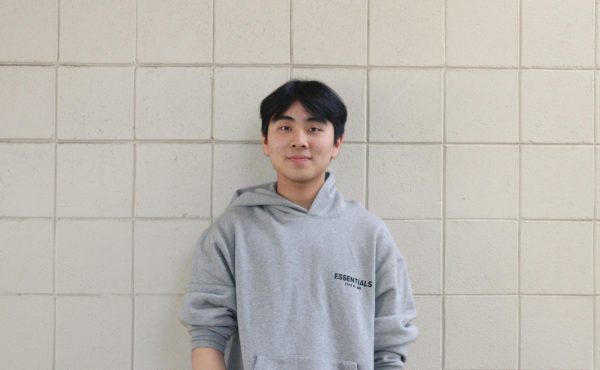The Santa Clara County Office of Education (SCCOE) recognized three teachers from the district for their leadership and inspiration, awarding them the 2023 Special Teacher Recognition Award on Oct. 23. Among the recipients was engineering teacher Audrey Warmuth, who has been teaching for 28 years, 17 of which have been at the school.
Recognized for her tireless efforts in launching the school’s STEM and engineering pathway, Warmuth was selected for the Innovation in STEM Award in the Perseverance category.
“Though I’m honored and grateful for the recognition, I feel very aware of how many really excellent teachers there are on campus who don’t get recognized,” Warmuth said.
From mechanical engineering to teaching
Originally a mechanical engineer, Warmuth worked for two years at Bombardier, an aviation company. Though an avid and successful engineer, she had always been interested in working more directly with people.
She decided to switch careers when, over 30 years ago, she picked up the self-help book “What Color Is Your Parachute” by Richard Nelson Bolles. The book opened her eyes to what she truly wanted: What mattered most to her was the people she collaborated with. Warmuth felt she was at the time in her life where she could shift careers, and since many of her colleagues at the time were teachers, she decided to repurpose her engineering skills and pivot toward teaching.
Establishing a new engineering program
Warmuth started teaching math at Lynbrook for 11 years before coming to SHS in 2006. She taught math here until 2021 and has been teaching engineering since the creation of the first STEM classes 11 years ago — STEM Lab, Principles of Engineering (POE), Digital Electronics (DE) and Engineering Design and Development (EDD).
Along with previous math and AP Computer Science teacher Debbie Troxel and physics teacher Kirk Davis — both of whom are also engineers by training — Warmuth began to look into existing programs at other schools. The team’s starting vision was to create a hands-on engineering course, planned for about a semester long.
After combing through many different curriculums, Paul Robinson, the principal at the time, suggested that they look into the curriculum and software provided by the Project Lead the Way (PLTW) program, which provides curriculum and software for engineering courses.
Following a busy pilot year in 2012, the STEM Lab course, which aimed to introduce engineering concepts, proved to be successful in teaching basic concepts like working with 3D models and cycling through the engineering design process. Along with physics teacher Matthew Welander, Warmuth expanded the curriculum from 2014 to 2016, teaching POE and DE, the next two classes in the engineering pathway.
The first few years of designing the engineering pathway were extremely tough to manage, worsened by the outdated curriculum that couldn’t keep up with the ever-shifting nature of engineering, she said.
“Their mechanism of teaching was duller than dishwater,” Warmuth said. “It was really death by PowerPoint and would have just bored students to death.”
Warmuth and Welander wanted to develop a way to impart the concepts without sacrificing the creative and engaging aspects of the projects.
From the fall 2014 to the spring of 2016, they would work multiple 3-hour sessions after school with her mentor, Dr. Gene Leichner, a retired engineer with a Ph.D. in Electrical Engineering.
Though he initially came to spend time with the school’s robotics teams, Leichner discovered the school’s engineering lab and offered to help with the development of the STEM curriculum. Despite never having a mentor or looking for one, Warmuth soon found Leichner to be a cherished mentor.
“[Leichner] was the mentor that I didn’t know I was missing in my life,” Warmuth said. “He was so unbelievably knowledgeable; he was patient with me and he was patient with the kids. He was always enthusiastic and positive about what we were doing, and he pushed us to make things engaging but still have technical relevance.”
With Leichner, the two adapted and adjusted the curriculum by splitting up the work, laying out ideas over the tables and scrapping ones that weren’t exciting or relevant to the latest standards in the industry.
Warmuth also worked with fellow educator Kristina Granlund-Moyer (whom she met during a summer training activity that helped teachers with teaching the PLTW curriculum) on putting together the curriculum for STEM Lab and with Welander and Leichner for POE and DE — sometimes adjusting the curriculum just a week before it was set to be taught in class. The following year, she established and taught the capstone course, EDD. After four years of work, the engineering pathway was completed in the spring of 2017.
Continued innovation during COVID-19: transitioning classes online
In the period following these early years of maximum effort and exhaustion, things started to settle down. However, distance learning during the epidemic brought a new wave of difficulties that especially affected the engineering classes, which are hands-on in nature. Not only did Warmuth have to figure out how to get students the hardware and the tools they needed in remote learning, but she also had to figure out alternatives for students who didn’t have computers capable of handling the necessary software installations, which would have normally been installed on lab computers.
“It was just almost like starting over again from scratch,” she said.
One change, originally intended for distance learning but has since been in place, was the introduction of Onshape, a new software for computer-aided design (CAD). Autodesk Inventor, the previous CAD software, was difficult and sometimes impossible to install on students’ personal computers. As a result, Warmuth and Welander switched to using Onshape, a cloud-based software that students could more easily use and ran on most students’ laptops.
Bouncing back from the pandemic and transitioning to in-person learning, Warmuth and Welander decided that the discarded junk in Room S03, a former woodworking shop, needed to be cleaned out and the workshop refurbished. As part of the Measure E Project, $2.5 million in funding was allocated for long overdue renovations, including heating and air conditioning, ventilation systems, rewiring of electrical panels and ceiling refurbishment.
Warmuth estimates she spent around 10 hours a week from August 2022 to February 2023 helping clear out and recondition the room, which had not been renovated for 50 years and was the last room on campus to be renovated since the school was first constructed in 1960.
“She’s done a lot of unpaid work in order to make this happen because she feels that it’s the right thing to do for students,” Welander said.
Warmuth’s perseverance and willingness to put in hard work to the STEM program were not her only highlights. In the award nomination form submitted by Public Information and Engagement Officer Tanya De La Cruz, she describes how Warmuth instills in her students the “invaluable lessons” about defining success and accomplishment for themselves and emphasizes a growth mindset through iterations and progress.
“Warmuth reiterates in every lesson that not succeeding on an attempt to do something doesn’t mean actual failure,” De La Cruz said. “She shares that engineering is all about problem solving and students are successful in the class if they learn what works [by successes] and what doesn’t work [by learning from on-hands experience].”
For example, in their capstone project for EDD, seniors define their individual projects and what constitutes success for themselves. Warmuth has students every year who persistently come in every 7th period to redesign or iterate their projects because they want to take on a more complex project. She said these projects are a “huge commitment” and that students sink a lot of personal time into it.
Sometimes, when the final product doesn’t turn out exactly the way they had pictured it, Warmuth reminds them that they are emerging from this process with more confidence and understanding of what was achieved along the way.
“Warmuth’s dedication and continued enthusiasm and love of STEM is evident in her daily interactions with students and her commitment to delivering a strong program,” De La Cruz said.
De La Cruz interviewed her and submitted an application for Warmuth for the 2023 Special Teacher Recognition Award. Warmuth received the well-deserved award for Innovation in STEM in the Perseverance category.
Said guidance counselor Brian Safine said: “[Warmuth’s] energy and enthusiasm around engineering has been the catalyst for our engineering program. Almost everything to do with engineering here has its roots in this woman’s teaching, and her enthusiasm for getting students involved in learning engineering.”



























